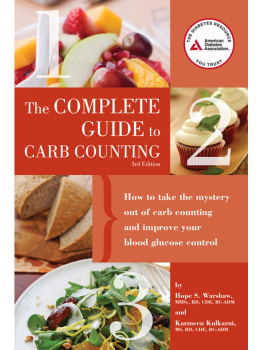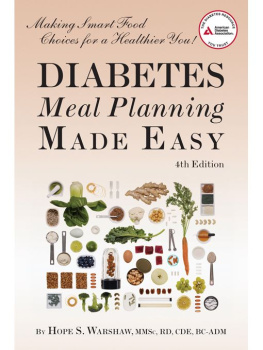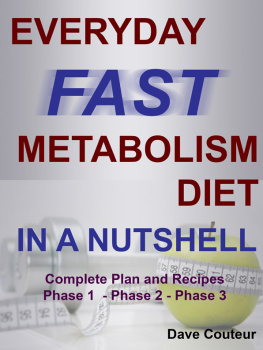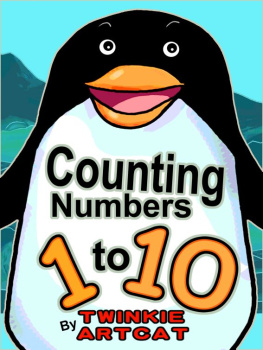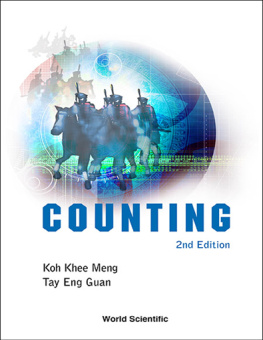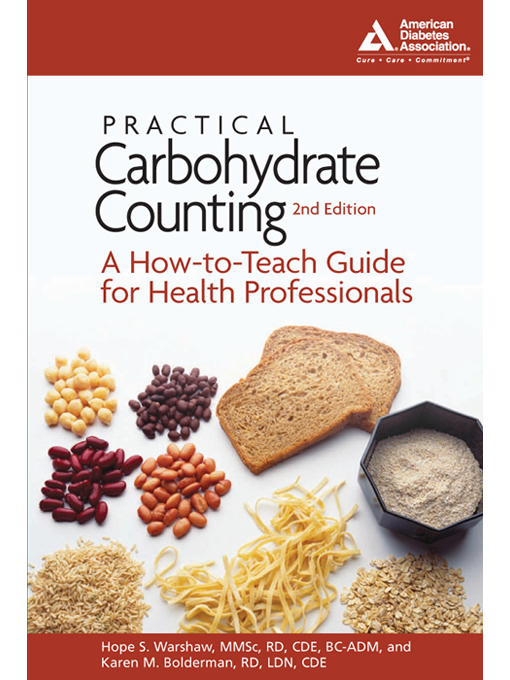P R A C T I C A L
Carbohydrate
Counting 2nd Edition
A How-to-Teach Guide
for Health Professionals
Hope S. Warshaw, MMSc, RD, CDE, BC-ADM, and
Karen M. Bolderman, RD, LDN, CDE

Table of Contents
Introduction
According to the American Diabetes Association (ADA), Medical Nutrition Therapy (MNT) is an integral component of diabetes management and diabetes self-management training (DSMT) (ADA 2008b). MNT has been shown, through clinical trials and outcome studies, to demonstrate decreases in A1C of approximately 1% in type 1 diabetes and 12% in type 2 diabetes (Pastors et al. 2002; Pastors, Franz, et al. 2003). By helping patients choose foods and plan meals to monitor their carbohydrate intake and achieve their MNT and diabetes care goals, carbohydrate counting is an attractive meal-planning approach (ADA 2008b).
The following MNT goals for diabetes management (ADA 2008b) are to:
1. Achieve and maintain (refer to Table I-1 for these goals):
a. Blood glucose levels in the normal range or as close to normal as is safely possible.
b. A lipid and lipoprotein profile that reduces the risk for vascular disease.
c. Blood pressure levels in the normal range or as close to normal as is safely possible.
2. Prevent, or at least slow, the rate of development of the chronic complications of diabetes by modifying nutrient intake and lifestyle.
3. Address individual nutrition needs, taking into account personal and cultural preferences and willingness to change.
4. Maintain the pleasure of eating by limiting food choices only when indicated by scientific evidence.

Regarding glycemic goals for infants, children, and adolescents, the ADA position statement Care of Children and Adolescents with Type 1 Diabetes states that near-normalization of blood glucose levels in children and adolescents is generally the same as that for adults (ADA 2005). However, the position statement details a number of caveats that discuss the greater risks of hypoglycemia and the difficulty of achieving tight glycemic control in this age population. The position statement specifies A1C goals that differ from the adult A1C goal for three age groups as follows:
Children <6 years old: 7.58.5%
Children 612 years old: < 8%
Adolescents: 7.5%
Making the necessary lifestyle changes to eat healthy with diabetes, in addition to acquiring and utilizing the knowledge to both prospectively and retrospectively manage glycemic control acutely and chronically, is one of the most challenging aspects of diabetes care. Helping people with diabetes achieve these goals is also challenging for their providers. Many factors contribute to the challenge of glycemic control, including those listed in Table I-2. Yet, it has been shown that people at varying levels of ability and motivation, as well as people implementing various diabetes therapies, can use carbohydrate counting to achieve short- and long-term glycemic and health goals (Anderson et al. 1993; DAFNE Study Group 2002).
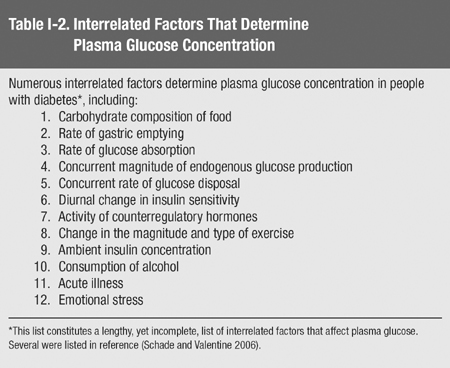
To help facilitate these established health outcomes, Practical Carbohydrate Counting: A How-to-Teach Guide for Health Professionals is designed to:
1. Provide educators with the concepts to cover when teaching Basic and Advanced Carbohydrate Counting
2. Help educators learn how to assess preexisting knowledge and abilities and determine if and when a person is ready to progress their level of carbohydrate counting
3. Discuss related dietary and nondietary factors, beyond the carbohydrate content of foods, that affect blood glucose control
4. Utilize case studies for Basic and Advanced Carbohydrate Counting that illustrate the use of this meal planning approach
5. Offer educators a variety of carbohydrate counting resources
CHAPTER ONE
What, Why,
Who, and
How Much?
CARBOHYDRATE COUNTING DEFINED
Carbohydrate Counting is an approach to meal planning that is often considered as two distinct methods with appropriate goals for each: Basic Carbohydrate Counting, a simpler approach, and Advanced Carbohydrate Counting, a progression of skills that entail more complex and time-intensive teaching. However, Basic and Advanced Carbohydrate Counting can also be considered a continuum of a single meal-planning approach, since a person must first master the concepts and skills of Basic Carbohydrate Counting before he or she can progress to Advanced Carbohydrate Counting.
The goals of Basic Carbohydrate Counting are, as expected, relatively minimal and often limited to learning the foods that contain carbohydrate and demonstrating knowledge of how to choose and eat these foods in the proper portions. People using Basic Carbohydrate Counting are encouraged to eat consistent amounts of carbohydrate at meals and snacks at similar times each day, with the end goal of achieving glycemic control and other diabetes and metabolic nutrition goals. Basic Carbohydrate Counting is most appropriate for people with type 2 diabetes who control their diabetes with a healthy eating plan and physical activity, with or without the addition of one or more blood glucoselowering medications.
The individual goals of Advanced Carbohydrate Counting are more varied and complex, but designed with the overarching objective of helping a person learn to synchronize the amount of glucose-lowering medication they take with the amount of carbohydrate consumed. This method of carbohydrate counting works well with the use of multiple blood glucoselowering medications (see suited to multiple daily injection (MDI) insulin regimens or a continuous subcutaneous insulin infusion pump (CSII), commonly known as insulin pump therapy.
People using Advanced Carbohydrate Counting are taught to use customized insulin-to-carbohydrate ratios (ICR) that are calculated based on their individual insulin and carbohydrate needs. They are also taught how to use a customized correction factor (CF), sometimes referred to as insulin sensitivity factor, to correct hyperglycemia and/or prevent further or future hypoglycemia. Ultimately, the use of Advanced Carbohydrate Counting is intended to help people enjoy a more flexible food and medication regimen that is more suited to contemporary daily life while simultaneously achieving improved glycemic control.
Both the Basic and Advanced methods of Carbohydrate Counting are fully described in later chapters.
THE CASE FOR CARBOHYDRATE COUNTING
Carbohydrate counting has grown in popularity as a meal planning approach in the United States since the completion of the Diabetes Complications and Control Trial (DCCT), in which carbohydrate counting was effectively used (Anderson et al. 1993; DCCT 1993). However, carbohydrate counting has been in use internationally since insulin was discovered and has been the meal planning method of choice in the United Kingdom for years (McCulloch et al. 1993).
Carbohydrate Counting has become popular for several reasons. First, the priority of achieving and maintaining glycemic control to decrease morbidity and mortality from diabetes complications has gained greater importance due to the results of the DCCT (DCCT 1993) and the United Kingdom Prospective Diabetes Study (UKPDS) in people with type 2 diabetes (UKPDS 1998). According to the American Diabetes Associations (ADA) most recent nutrition recommendations and interventions, control of blood glucose to achieve glycemic control is a primary goal of diabetes management (ADA 2008b). Second, more attention is now focused on postprandial blood glucose control (Parkin and Brooks 2002) because of the finding that it is more strongly associated with the risks for atherosclerosis than preprandial blood glucose (Temelkova-Kurktschiev 2000). People with diabetes have defects in insulin action, insulin secretion, or both, and insulin defects impair the regulation of postprandial glucose in response to carbohydrate intake. The quantity and the type/source of carbohydrate intake are the major determinants of postprandial glucose levels (ADA 2008b). Interventions to help people accurately count and control their carbohydrate intake are important to help improve postprandial glycemic control.


